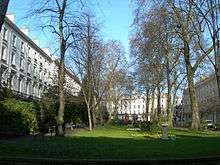Porchester Square

Porchester Square is a typical London garden square is located in the Bayswater neighbourhood of the City of Westminster, just south of the main railway line out of London Paddington station. The name Porchester comes from one of the Hampshire estates of the Thistlewaites who with only two or three other families had been chief lessees of the Bishop of London's land in Paddington since before 1750. The rectangular plot of land was developed in the first half of the 19th century, with a variety of builders involved, resulting in slightly different exterior details in the surrounding houses (now all converted into flats), though porticoed steps to the front doors, sash windows, first floor balconies with wrought iron railings and roofline balustrades are all standard features.
One unusual though not unique feature of this square is that the houses bordering the northern side of the square do not face the square as one would expect, but back onto it without any intervening road. A curious consequence is that the road onto which they do face has two names - Porchester Square on its southern side, but Gloucester Terrace on its northern.
The houses on the south side of the square, while retaining their facades and much of their internal structure, were incorporated into an award-winning substantial private development of flats and commercial premises in the mid-1970s, called The Colonnades. This development was one of the first major projects of the now leading architects, Sir Terry Farrell CBE and Sir Nicholas Grimshaw CBE.
The central gardens of the square which are open to the public, and include a children's playground, are among the most attractive in west London. In addition to the magnificent, tall London Plane trees (Platanus x hispanica), there are flowering Cherry trees, extensive lawns and colourful flower beds.[1]
Begun in 1850 and completed between 1855 and 1858, Porchester Square was one of the last areas of Bayswater to be built. Eight different builders were involved with different parts of the square as can be seen from a variety of exterior details on the houses. The architect most closely concerned with Porchester Square was George Wyatt, but the final word on both the general layout and the architectural detail would have been with George Gutch who in 1822 became the surveyor of Bishop of London's Paddington estate and so supervised the overall development of the whole of Bayswater. The name Porchester comes from one of the Hampshire estates of the Thistlewaites who with only two or three other families had been chief lessees of the Bishop of London's land in Paddington since before 1750.